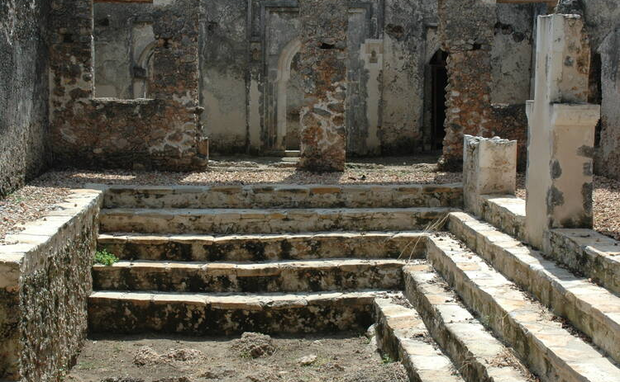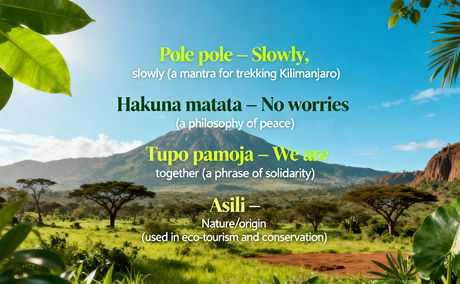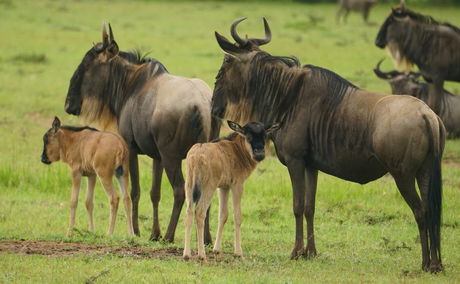For the eco-conscious traveler, a trip to Tanzania is a quest for authentic connection. This article reveals that the most powerful tool for achieving this isn't found in your backpack, but in your voice: the Swahili language. Moving beyond basic phrasebooks, we explore how Swahili is your key to responsible and transformative travel. It's a language born of trade and cultural exchange, making it inherently welcoming. We uncover how using Swahili fosters...
Discover Tanzania’s World Heritage Sites: A Journey Through Nature and Culture

The article invites readers to explore UNESCO-recognized heritage sites across Tanzania, blending natural wonders with deep cultural legacy — and encourages eco-friendly, sustainable travel through Kijani Tours.
kijanitours.com
What Makes Tanzania’s Heritage Special
Tanzania hosts seven major UNESCO World Heritage Sites, each offering unique experiences: ancient rock art, ruined trading cities, historic Swahili towns, volcanoes, wild savannahs and dense wildlife habitats.
On the cultural side:
Kondoa Rock‑Art Sites — ancient rock shelters filled with paintings by hunter-gatherer and early pastoralist communities.
Ruins of Kilwa Kisiwani & Ruins of Songo Mnara — remains of historic Swahili-coast trading cities that once linked East Africa to global Indian Ocean trade networks.
Stone Town of Zanzibar — a living example of Swahili-Arab-Indian-European architectural and cultural fusion, with narrow alleys, carved doors and lime-washed houses.
On the nature side:
Serengeti National Park — vast savannah plains famed for the Great Migration, abundant biodiversity, and iconic African wildlife.
UNESCO World Heritage Centre
Ngorongoro Conservation Area — home to the dramatic volcanic crater, diverse ecosystems, and important archaeological sites such as early human fossils.
Selous Game Reserve and Kilimanjaro National Park — offering natural wilderness, biodiversity and landscapes ranging from forested highlands to plains and mountain terrain.
Why It Matters: Heritage + Community + Conservation
The post highlights how heritage sites in Tanzania are vital — not only for preserving nature and history, but as catalysts for sustainable tourism.
It advocates for responsible travel: tourists visiting these heritage sites can contribute to preserving biodiversity and support local communities.
It emphasizes the need to balance tourism and conservation. Threats like over-tourism, environmental pressure, and lack of awareness must be managed carefully to protect these treasures for future generations.
Final Thought: Travel with Purpose
The article calls on travelers to go beyond sightseeing — to explore with awareness and respect, understanding that by visiting heritage sites, they become part of a broader movement to protect cultural legacy, biodiversity, and community well-being.
Introduction
Step into a world where every stone and landscape whispers tales from centuries past, a realm where the stories of your ancestors can still be felt. Welcome to Tanzania, where breathtaking parks and historic towns paint a captivating picture that attracts adventurers from across the globe. Yet, there is so much more to these stunning sites than meets the eye; they play a crucial role in how we connect with and safeguard our planet.
Sustainable tourism is not just a trend; it is a powerful way to travel that benefits both the environment and local communities. Central to this movement are the World Heritage Sites—a source of inspiration that fosters respect, stewardship, and a deep appreciation for our history and natural beauty.
Kijani Tours shines brightly as a leading travel partner that prioritizes responsible tourism, offering eco-friendly adventures at Tanzania's most iconic locations. Join us on this journey to uncover how Tanzania's rich heritage sites enhance sustainable tourism, and discover how you can be a part of this vital movement. Let us come together to explore, appreciate, and protect the beauty of our world.
The Significance of World Heritage Sites in Tanzania
Tanzania stands as a proud guardian of an incredible cultural and natural heritage, boasting seven remarkable UNESCO World Heritage Sites. These sites tell captivating stories of our past and the importance of conserving our environment.
Among these treasures are the Kondoa Rock Art Sites, which hold ancient artistry that connects us to our ancestors; the Ruins of Kilwa Kisiwani and Songo Mnara, remnants of long-gone city-states that played significant roles in global trade; and the historic Stone Town in Zanzibar, a vibrant fusion of cultures that resonates with history.
In addition to these cultural landmarks, Tanzania is home to breathtaking natural wonders, including the sprawling Selous Game Reserve, the majestic Kilimanjaro National Park, the iconic Serengeti National Park, and the stunning Ngorongoro Conservation Area. Each of these locations is not just a feast for the eyes but also critical to biodiversity and ecological balance.
Achieving UNESCO status not only brings heightened attention to these incredible sites but also emphasizes the essential need for their preservation. It mobilizes global awareness around conservation efforts and inspires investment towards maintaining these exceptional locations. By championing these heritage sites, we pave the way for future generations to experience and learn from our shared history and natural beauty. Let’s celebrate and protect our heritage together.
Cultural and Natural Heritage as a Catalyst for Sustainable Development
Heritage sites are a beacon for eco-conscious traveler’s eager for more than just a snapshot. These adventurous souls seek genuine experiences that immerse them in local customs and the beauty of nature. When visitors approach these sites with respect, it not only benefits the surrounding communities but also the wildlife that calls these places home.
By exploring these unique destinations, travelers play a vital role in supporting local economies and conserving biodiversity. It creates a wonderful opportunity for community members to showcase their culture while earning a living. This positive feedback loop fosters both conservation efforts and community development, proving that they truly go hand in hand.
Challenges Facing Heritage Conservation in Tanzania
While challenges do loom ahead, there is so much we can do. Rapid urbanization, illegal poaching, climate change, and an influx of tourists are all putting pressure on our precious heritage sites. Striking a balance between protecting these treasures and promoting economic growth is indeed a challenge, but it is not impossible.
Imagine setting visitor limits that help preserve these sites or supporting innovative conservation projects that ensure their survival for future generations. Education plays a pivotal role here—by inspiring both visitors and locals to cherish and protect our cultural gems, we can create a thriving community that respects and enhances the legacy of our heritage. Let us rally together and make a difference.
Conclusion: Be a Part of Tanzania’s Sustainable Legacy
Tanzania’s World Heritage Sites tell a captivating story of history, culture, and nature, from the ancient rock art of Kondoa to the endless plains of the Serengeti. These sites are more than just destinations—they are opportunities to travel responsibly. With Kijani Tours, your adventure directly supports local communities and vital conservation efforts. Join the movement, explore mindfully, and share your journey using to help preserve Tanzania’s treasures for future generations
Start Your Sustainable Travel Journey
Ready to explore Tanzania responsibly? Start your sustainable travel journey with Kijani Tours and experience eco-friendly safaris, community-led adventures, and meaningful cultural encounters—all designed to protect nature and empower local communities. Your conscious adventure begins here.
Adventure with Impact: Experience Tanzania Through Kijani Tours
Travel Deeper: How Cultural Respect Creates Truly Sustainable Tourism 1) True sustainability goes beyond eco‑habits—it begins with a respectful mindset toward local cultures. 2) Cultural respect strengthens the three pillars of tourism: environmental protection, economic resilience, and socio‑cultural preservation. 3) Empowering communities as guardians, artisans, and storytellers ensures conservation and dignified livelihoods. 4) Travel becomes legacy‑building when it shifts from extraction to authentic human connection.
This blog explores the breathtaking drama of the wildebeest calving season in Tanzania’s southern Serengeti, where over 500,000 calves are born within a few short weeks between January and March. It highlights the synchronized birthing strategy known as predator satiation, which helps ensure survival by overwhelming predators, such as lions, cheetahs, and hyenas, with sheer numbers. The piece captures the emotional intensity of this natural phenomenon—where life and death unfold in real...





Share This Post